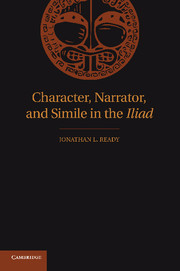Book contents
- Frontmatter
- Contents
- Acknowledgments
- Introduction
- 1 The Simile and the Homeric Comparative Spectrum
- 2 Similes and Likenesses in the Character-Text
- 3 A Preparation for Reading Sequences of Similes
- 4 Sequences of Similes in the Character-Text
- 5 Narrator, Character, and Simile
- 6 Similes in the Narrator-Text
- Conclusion: The Odyssey Compared
- Abbreviations
- Bibliography
- Index Locorum
- Index of Names, Subjects, and Greek Words
1 - The Simile and the Homeric Comparative Spectrum
Published online by Cambridge University Press: 03 May 2011
- Frontmatter
- Contents
- Acknowledgments
- Introduction
- 1 The Simile and the Homeric Comparative Spectrum
- 2 Similes and Likenesses in the Character-Text
- 3 A Preparation for Reading Sequences of Similes
- 4 Sequences of Similes in the Character-Text
- 5 Narrator, Character, and Simile
- 6 Similes in the Narrator-Text
- Conclusion: The Odyssey Compared
- Abbreviations
- Bibliography
- Index Locorum
- Index of Names, Subjects, and Greek Words
Summary
a study of the homeric simile can begin by defining its terms. I propose to accomplish this preliminary task by looking at the larger question of statements in the shape “A (is) like B” in the Homeric poems. Glaukos' famous contention that men resemble leaves is a good place to start:
οἵη περ φύλλων γενεή, τοίη δὲ καὶ ἀνδρῶν.
φύλλα τὰ μέν τ' ἄνεμος χαμάδις χέει, ἄλλα δέ θ' ὕλη
τηλεθόωσα φύει, ἔαρος δ' ἐπιγίγνεται ὥρη·
ὣς ἀνδρῶν γενεὴ ἡ μὲν φύει ἡ δ' ἀπολήγει.
As is the generation of leaves, so that also of men.
Some leaves the wind pours out on the ground, but others the wood
flourishing produces, and the season of spring returns:
so the generation of men, one grows, the other dies.
(Il. 6.146–49)Hayden Pelliccia suggests that Glaukos' figure strongly asserts the similarity between tenor (i.e., “the generation of men”) and vehicle (i.e., “the generation of leaves”), whereas the purpose behind a simile comparing, for example, Achilleus to a leaping lion “does not seem to be to assert what Achilles is like, but to bring his leaping more vividly to the eye” (2002: 199). The idea that different Homeric statements in the shape “A is like B” reveal different degrees of similarity between tenor and vehicle appears elsewhere.
Information
- Type
- Chapter
- Information
- Character, Narrator, and Simile in the Iliad , pp. 11 - 26Publisher: Cambridge University PressPrint publication year: 2011
